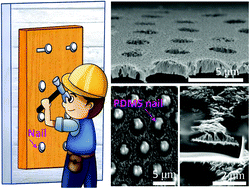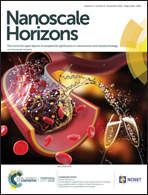High-adhesion vertically aligned gold nanowire stretchable electrodes via a thin-layer soft nailing strategy†
Abstract
A stretchable electrode is a crucial component in future elastronics (i.e. stretchable electronics) with implications in soft actuators, healthcare monitoring, and robotics to name a few. The performance of the stretchable electrode is generally evaluated in terms of three key aspects: sensitivity, stretchability, and durability. While encouraging progress has been made in the first two aspects, long-term stability remains a challenge because of failure at the soft/hard materials interface between active materials and elastomeric substrates. Here, we propose a new microsphere lithography-based strategy to pattern vertically aligned gold nanowires (v-AuNWs) with quasi-ordered pinholes, allowing ‘nailing’ of PDMS into the pinholes. This enabled substantially enhanced interfacial adhesion of 24 times greater than that without microsphere lithography. Moreover, the pinhole size in the v-AuNW film could be tuned from an average diameter of 0.4 to 2.8 μm. Both experimental and simulation results demonstrate that the sensitivity increased as the pinhole size increased. Our strategy represents a novel route to fabricate robust elastronic electrodes for potential applications in next-generation wearable and implantable devices.



 Please wait while we load your content...
Please wait while we load your content...